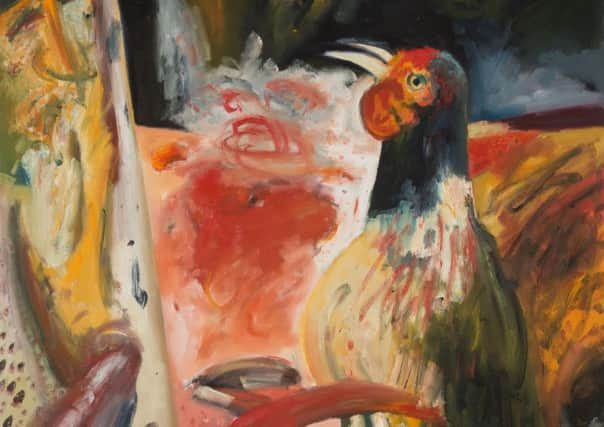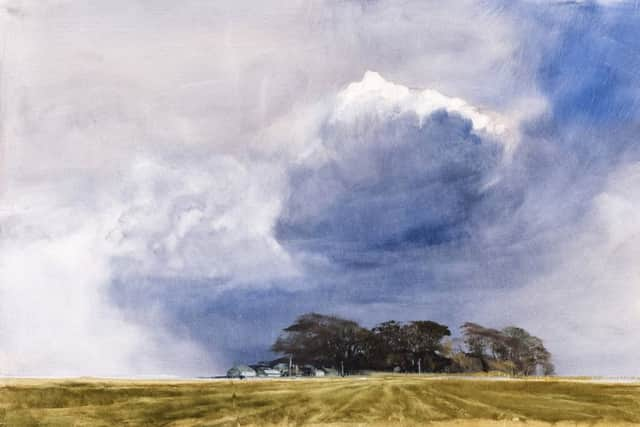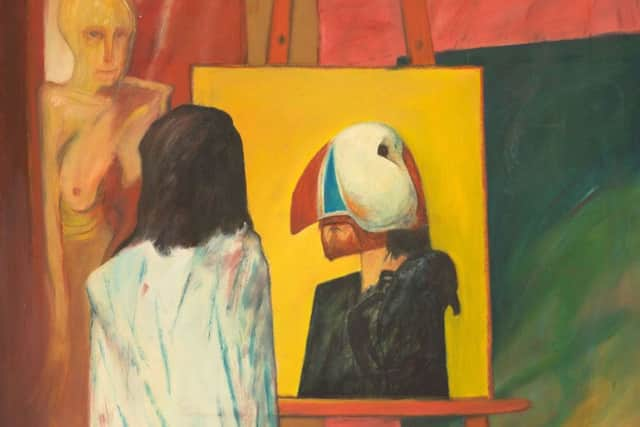Art reviews: John Bellany | Joan Eardley | Audrey Grant


John Bellany: The Capercaillie’s Song
Star rating: *****
Open Eye Gallery, Edinburgh


Joan Eardley: In Context
Star rating: ****
James Morrison: The North Wind
Star rating: ****


Scottish Gallery, Edinburgh
Audrey Grant: With all its eyes the natural world looks out into the Open Star rating: ****
Union Gallery, Edinburgh
My job, as I see it, has never been to lay a tit’s egg, but to erupt like a volcano, emitting not only flame, but a lot of rubbish [too]”, thus Hugh MacDiarmid memorably summarised his idea of what kind of a poet he was. Tit’s eggs were never for John Bellany either. His creativity, too, was volcanic and his output prodigious, but inevitably, even if he did not produce a lot of rubbish along with the flames, he could be uneven. Nor was he always a severe enough critic of his own work, so a good Bellany exhibition has to be carefully selected. That was certainly true of the major retrospective in 2012, a brilliant show which did full justice to his best work. Happily too he lived to enjoy its success, crowning a career that sadly ended when he died early the following year, not very long after the exhibition closed.
Advertisement
Hide AdThe Capercaillie’s Song at the Open Eye is the first major show of his work in Scotland since his death, so it could be seen as a memorial, but if it is, that is not just a matter of timing. Selected by Helen Bellany, the artist’s widow, this really is a memorial show in a very personal way, for although it is the first exhibition of his work that she has ever selected, she brings to it a unique insight into the artist, the art and the stories that it tells. She has also chosen highs throughout. There is no volcanic rubbish here, only fire. Nor is the show burdened with the claims of a retrospective. Filling in a narrative, however summarily, means that retrospectives can be uneven. In contrast, this show really is a song as its title promises although in fact in real life the capercaillie scarcely sings. Rather it makes a variety of clicks and guttural croaks, but this not ornithology.
In the titular picture, the Capercaillie Sings from 1984, Bellany’s great Scottish bird really does sing whatever ornithology would decree. Big and bold, in brilliant plumage of red, blue and green, head back, it is giving voice with pride and confidence. It is a fitting image of the artist at his best.
The most recent work here is from 2008, but it ranges back over his career to student drawings from the early sixties. Robin Philipson, who was Head of Painting at Edinburgh College of Art, recognised the astonishing talent of his student for all his waywardness. Never burdened with undue modesty, Bellany used to take pleasure in recalling him saying, “I have got a student who can draw like Titian.” And indeed he could. From the very first his drawings are outstanding in their fluency and confidence, but also in the boldness of the images he makes as in Sleeping Nude, or Nude with Hoop, for instance. Both were done when he was a student, but already he makes an ordinary life study monumental and, above all, into something humane. He could never look at a human being and see just so much form. His sitters have lives and he lets us know it. Though he scarcely flatters her, a portrait of Helen from 1967 displays to the full the unerring strength of line he could deploy, apparently without hesitation or correction, but boldly straight onto the page. A self-portrait called the Sad Pianist is made with little more than a single zig-zag line. But he was not limited to line. One of the most astonishing images here is Antoinette. She is posing with hands clasped and eyes raised like a repentant Magdalene and Bellany uses ink and wash to give her picture a wild intensity that few could match. The qualities of his drawing inform his printmaking too, especially his etchings, and there is a good selection of them here.
There are some really grand paintings too, however. A Long Night’s Journey into Day from 1987 occupies a whole wall. There are lyrical watercolours, too, and wild paintings of mysterious sea creatures and phallic lighthouses exploding against the sea. Two of the finest pictures, Self-Portrait with a Dog and Celtic Sacrifice, date from the early seventies, around the time that he and Helen separated. They are not wild, however, but bleak and tense. Self-Portrait with a Dog in harsh yellows and reds shows his self-portrait on the easel, but the face is half hidden by a puffin mask. A shrouded figure and a sinister spotted dog stand in front of him. If it were possible, Celtic Sacrifice is even bleaker. Against a blood-red background, a totem figure supports the burden of a creature that seems half dog, half-fish. Bellany’s familiars, puffin, skate and dog are in attendance below on an altar decorated with the stripes of Buchenwald pyjamas.
Joan Eardley and John Bellany both painted the sea, but though they agreed on its power, they treated it very differently. For Bellany it was the boundless and often ominous territory of the imagination. For Eardley it was simply an elemental force. At the Scottish Gallery, the star among an interesting selection of her paintings and drawings is a magnificent seascape painted on the shore at Catterline, no doubt in the face of wild wind and weather. There are two boats drawn up on the beach. One is bright blue and apparently she has used the actual blue paint with which the last of the salmon cobles to work from Catterline was painted. It’s a loaded detail that brings Eardley closer to Bellany’s poetic vision than you might expect.
Eardley is also shown alongside work by those who were close to her. There is a beautiful small painting of cottages at Catterline by Lillilan Nelson, for instance, and a study of a boy reading by Angus Neil that could almost be by Eardley herself. Most intriguing though are paintings by James Morrison whose recent work is also showing upstairs. Morrison moved to Catterline at much the same time as Eardley herself started to paint there. A still life, Lamps, Catterline, is a souvenir of that time and its thin, fluid execution seems to prefigure his later work. On the other hand Landscape near Catterline from 1963 shows more influence of French abstract painting than is ever visible in Eardley’s work, however much she may have paid attention to it.
Advertisement
Hide AdMorrison’s association with Eardley was an inspiring beginning to a career that is still flourishing, as the works upstairs make clear. For a long time now he has painted the wide landscapes of Strathmore and the Montrose Basin in a unique style. He uses the relative proportions of sky and land as we actually experience them, rather than as they have evolved in the conventions of landscape. This creates enormous skies and to describe them he uses oil paint like transparent watercolour. It is a long way from Eardley’s wild, impasted paint with windblown sand embedded in it, but it creates depth, light and distance and so a dramatic sense of our own puny human scale.
Eardley has a different and more distant successor in Audrey Grant showing at the Union Gallery. Recently Grant has started working on photographs to make rough, but evocative seascapes. However, her show consists mainly of paintings of single female figures, either sitting or standing against blank walls and, in one group, with words from the poems of Rilke written like graffiti behind them. Whether consciously or not, there is an echo here of Eardley’s Children and Chalked Wall paintings, but in the existential starkness of the figures’ isolation, they also recall Giacometti. Hers is a talent to watch.
• John Bellany until 2 September; Joan Eardley and James Morrison until 5 September; Audrey Grant until 7 September